Craving the ultimate comfort food but want to keep it plant-based? Look no further! This vegan meatloaf recipe masterfully captures all the rich, savory flavors and satisfying textures of a classic meatloaf, offering a hearty and wholesome alternative that tastes truly incredible. It’s not just a meal; it’s a nostalgic trip back to cherished childhood dinners, reimagined for a healthier, compassionate lifestyle.
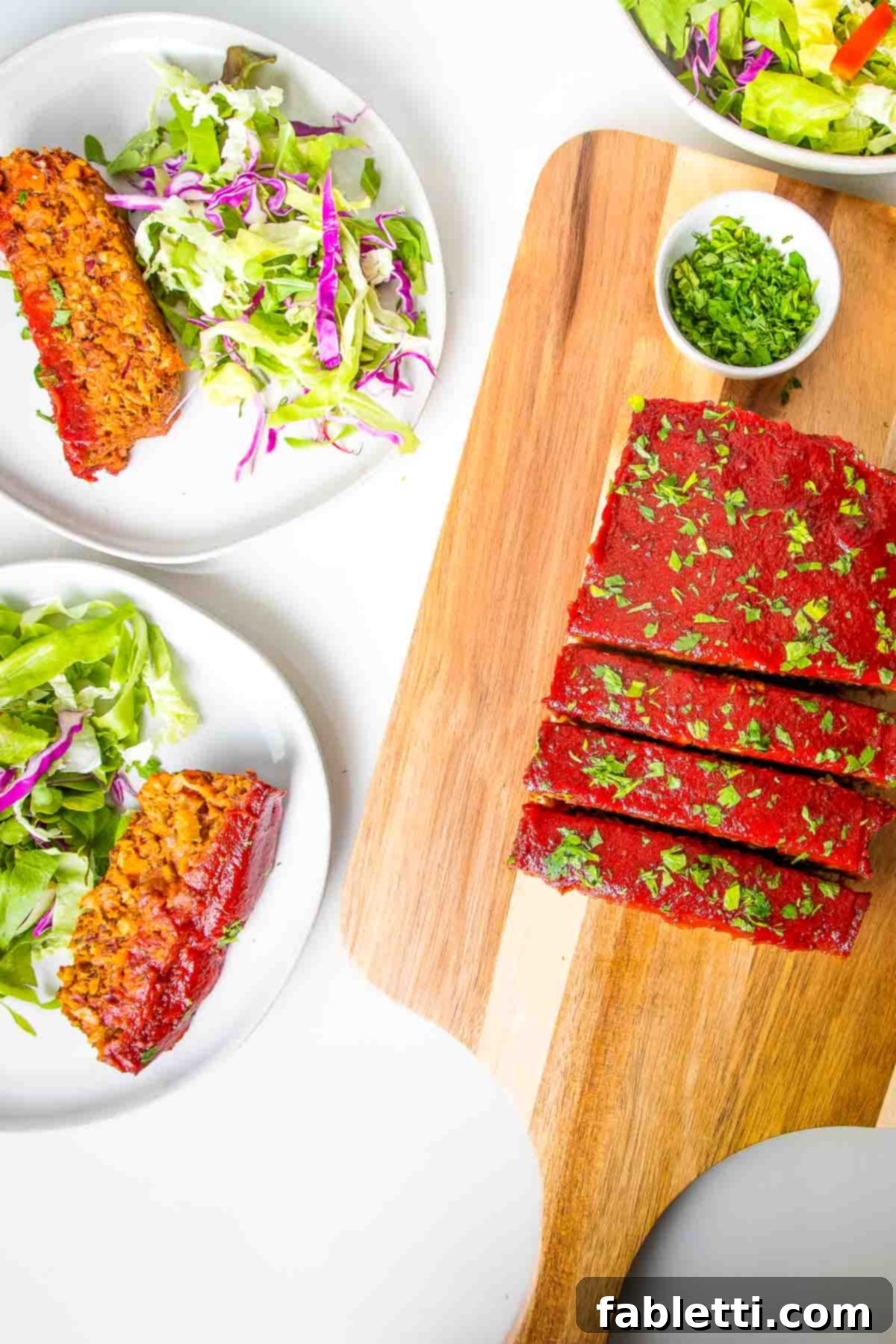
Are you among the growing number of people searching for a truly outstanding vegan meatloaf recipe? You’re not alone! As the seasons change and the air turns crisp, the demand for cozy, satisfying comfort food inevitably rises. It’s a natural craving, and with an increasing focus on health and plant-based eating, many are seeking a healthier, meatless version of this beloved dish.
I completely understand this desire for nourishing comfort, and I’m thrilled to share what I believe is the best plant-based meatloaf recipe you’ll find. This recipe isn’t just a substitute; it’s a culinary experience designed to be deeply flavorful and incredibly satisfying. For the full nostalgic experience, whip up a batch of creamy vegan mashed potatoes to serve alongside – you’ll have a healthy, comforting meal that feels just like home, ready to grace your plate very soon!
Essential Ingredients & Smart Substitutions for Your Vegan Meatloaf
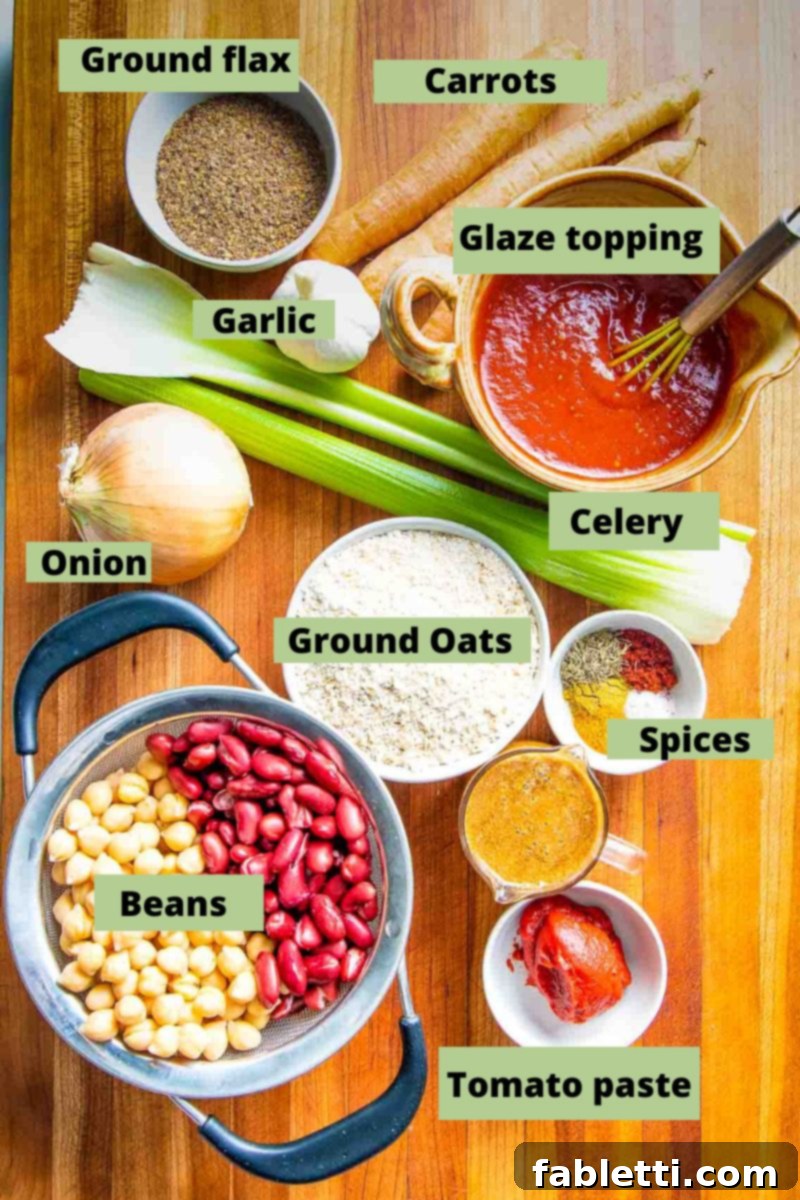
Creating an exceptional vegan meatloaf starts with carefully selected ingredients that not only contribute to flavor but also provide the essential structure and nutrients. Each component plays a vital role in achieving that perfect texture and taste, ensuring a satisfying meal every time. Here’s a detailed look at the core ingredients and how you can adapt them to your pantry or dietary needs:
- Mashed Beans: The foundation of our plant-based meatloaf, a combination of fiber-rich kidney beans and chickpeas provides a robust source of plant-based protein and acts as a superb binder, holding the loaf together without needing any animal products. The varied textures of these beans, when mashed, mimic the consistency of ground meat beautifully.
- Substitution Tip: Feel free to experiment with any combination of beans you have available. Cannellini beans, pinto beans, great northern beans, or even cooked lentils can be used interchangeably for similar fantastic results. Aim for about 2 cans (or approximately 3 cups cooked) for the optimal consistency.
- Aromatic Vegetables: A classic meatloaf gets its depth of flavor from a medley of sautéed onions, carrots, and celery. These “holy trinity” vegetables, when softened and infused with traditional meatloaf spices, create a rich savory base that is both comforting and incredibly tasty.
- Substitution Tip: Don’t hesitate to get creative with your veggie choices. Leeks can offer a milder oniony flavor, fennel adds a hint of licorice-like sweetness, or parsnips can contribute an earthy, peppery note. Any combination of these or other root vegetables you enjoy will work wonderfully.
- Ground Oats and Ground Flaxseed: These gluten-free powerhouses are the vegan binders that ensure your meatloaf maintains its shape and moist texture. Ground oats provide bulk and a subtle chewiness, while ground flaxseed, when mixed with liquid, creates a gel-like consistency that replaces eggs, making this recipe accessible for those with gluten and egg sensitivities.
- Substitution Tip: For a completely grain-free option, substitute the ground oats with additional ground flaxseed or almond flour. Ensure the ratio is adjusted to maintain the desired binding and texture.
- Tamari, Plant-Based Milk, and Vegan Worcestershire Sauce: A common pitfall for meatloaf (vegan or otherwise) is dryness. This dynamic trio is key to ensuring our vegan meatloaf remains incredibly moist and bursts with umami-rich flavor. Tamari offers a salty, savory depth, vegan Worcestershire sauce adds a complex tangy note, and plant-based milk provides essential moisture.
- Substitution Tip: Any plant-based milk (almond, soy, oat, or cashew) can be used. Opt for low-sodium tamari if you’re mindful of salt intake, or use regular tamari if preferred.
- Tangy Glaze Topping: For many, the glaze is the crown jewel of any meatloaf! Our homemade glaze, a vibrant blend of apple cider vinegar, rich tomato paste, and coarse whole-grain mustard, delivers the perfect balance of sweetness and tanginess. It caramelizes beautifully during baking, creating an irresistible top layer that complements the savory loaf below.
Why You’ll Absolutely Love This Vegan Meatloaf

This isn’t just another vegan recipe; it’s a testament to how flavorful and satisfying plant-based eating can be. Prepare to fall in love with this meatloaf for a multitude of reasons:
- Incredible Flavor: Each bite is a symphony of savory spices and the delightful tang of our homemade tomato glaze. The careful balance of seasonings ensures a rich, complex taste that will surprise and satisfy even the most discerning palates.
- Perfect Texture: Achieving the right texture in a vegan meatloaf can be challenging, but this recipe nails it. It’s wonderfully moist, yet firm enough to slice cleanly, providing that comforting, hearty mouthfeel without being mushy.
- Hearty and Satisfying: Packed with wholesome beans and vegetables, this meatloaf is genuinely filling and deeply satisfying, making it an ideal centerpiece for any meal, especially on a chilly evening.
- Rich in Fiber: Thanks to the generous use of beans, oats, and vegetables, this meatloaf is a fantastic source of dietary fiber, promoting digestive health and helping you feel fuller for longer.
- Made with Wholesome, Real Food: You won’t find any artificial ingredients here. Every component is a real, whole food, ensuring you’re nourishing your body with natural goodness.
- Vegan and Gluten-Free: Thoughtfully crafted to be both vegan and gluten-free, this recipe ensures that virtually everyone can enjoy a slice of this delicious comfort food, making it perfect for diverse dietary needs.
- Ideal for Meal Prep: This meatloaf is a dream for meal planning. It reheats beautifully, retaining its flavor and texture, and freezes exceptionally well, making it easy to enjoy healthy, homemade meals throughout the week.
While the recipe notes might indicate a considerable total time, don’t let that deter you! A significant portion of that is passive time – simply waiting for your delicious meatloaf to bake to perfection in the oven. This allows you to multitask, whether it’s assisting with homework, tackling laundry, prepping other meals for the week, returning phone calls, or simply unwinding with a good book. Let your meatloaf cook itself while you manage your busy schedule or indulge in some well-deserved relaxation!
Step-by-Step: Crafting Your Delicious Vegan Meatloaf
Creating this wholesome vegan meatloaf is a straightforward process that yields incredibly rewarding results. Follow these simple steps to bring this healthy comfort food to your table.
Begin by preheating your oven to 375°F (190°C). This ensures your oven is at the optimal temperature for even baking once your meatloaf is ready.
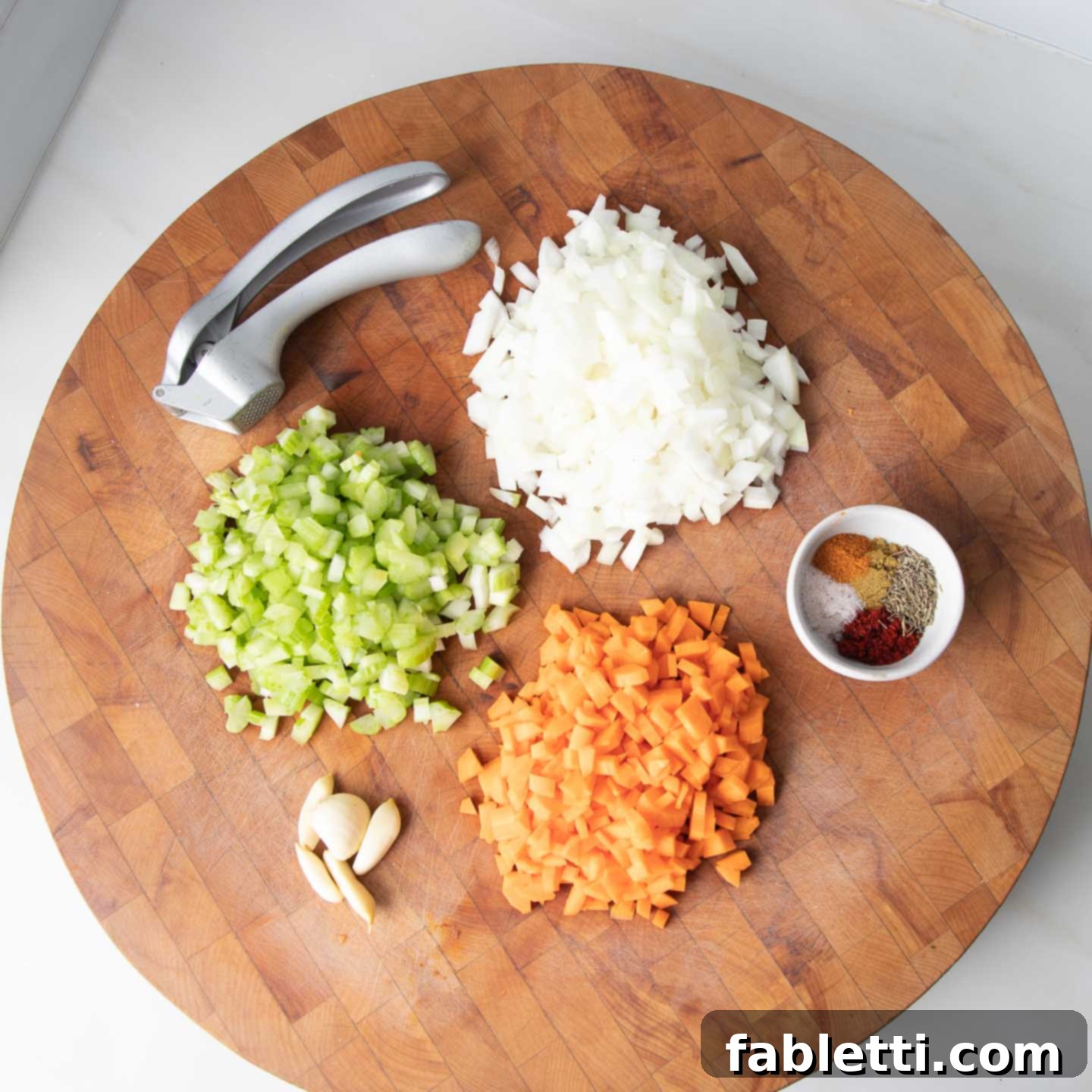
Step 1: Prepare Your Veggies. Start by finely dicing your onions, celery, and carrots. Press the garlic cloves to release their aromatic oils, and measure out all your spices. This mise en place makes the cooking process smooth and enjoyable.

Step 2: Sauté the Aromatics. In a heavy skillet, heat a little water, vegetable broth, or olive oil over medium heat. Add the diced onions, carrots, celery, and spices. Cook for about 5 minutes, stirring occasionally, until the vegetables are tender. Stir in the pressed garlic for one minute until fragrant, then remove from heat.
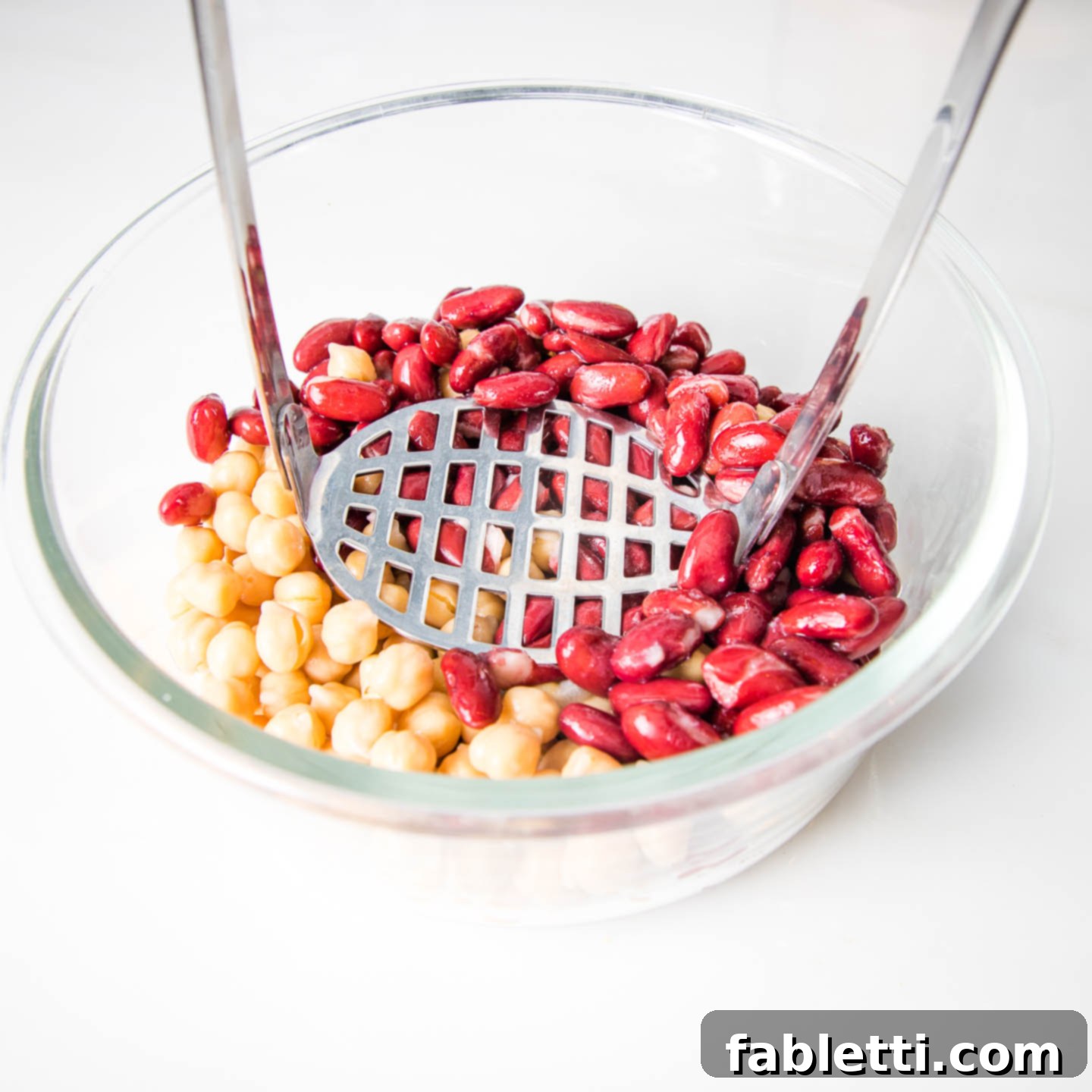
Step 3: Prepare the Beans. While your vegetables are sautéing, rinse and drain the kidney beans and chickpeas thoroughly. Transfer them to a large mixing bowl, ready for mashing.

Step 4: Mash the Beans. Using a potato masher or a sturdy fork, mash the beans in the bowl. Aim for a varied texture, leaving some chunks for substance while mashing others more finely for binding. This creates a satisfying, “meaty” consistency.

Step 5: Combine Wet and Dry Binders. To the mashed beans, add the plant-based milk, vegan Worcestershire sauce, tamari, tomato paste, ground oats, and ground flaxseed. Mix thoroughly with a fork until all ingredients are well incorporated, forming a cohesive mixture that will bind our loaf.
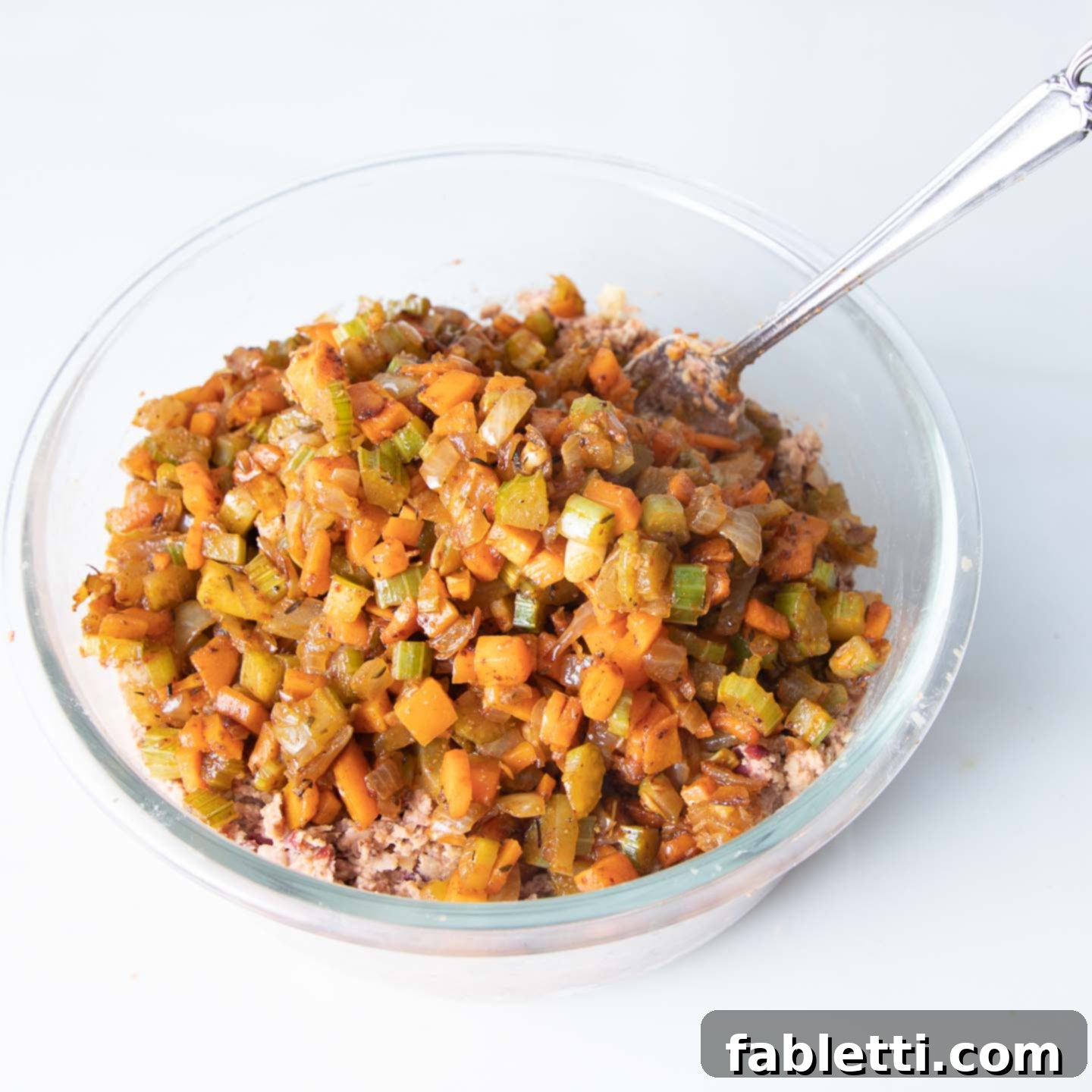
Step 6: Integrate the Sautéed Vegetables. Gently fold the cooled, sautéed vegetable mixture into the bean and binder mixture. Continue mixing until everything is evenly combined, ensuring the flavors and textures are distributed throughout the loaf.
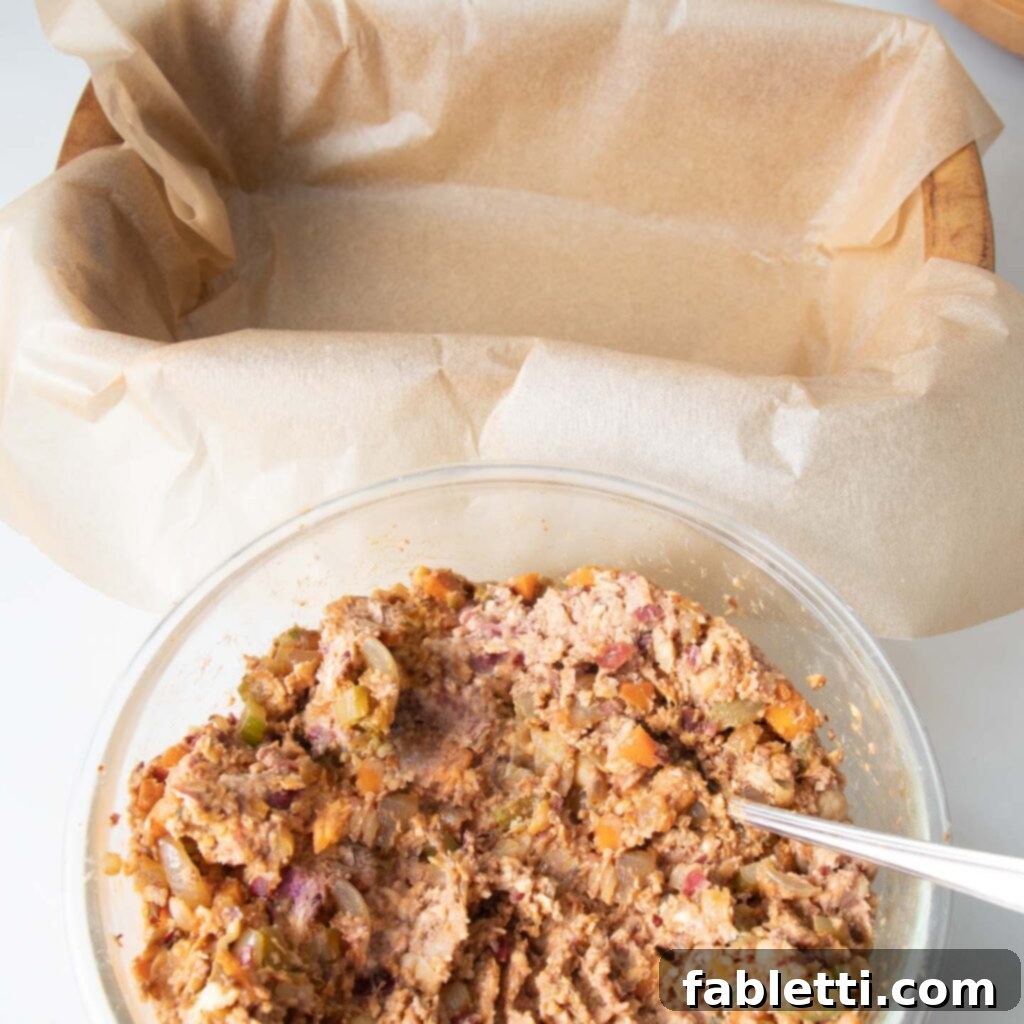
Step 7: Prepare the Loaf Pan. Line a standard loaf pan with unbleached parchment paper, leaving an overhang on the sides. This step is crucial for easy removal of the baked meatloaf later. Once lined, spoon the bean mixture into the prepared pan.

Step 8: Fill the Loaf Pan. Spoon the entire bean mixture evenly into the parchment-lined loaf pan. Ensure it is distributed from corner to corner.
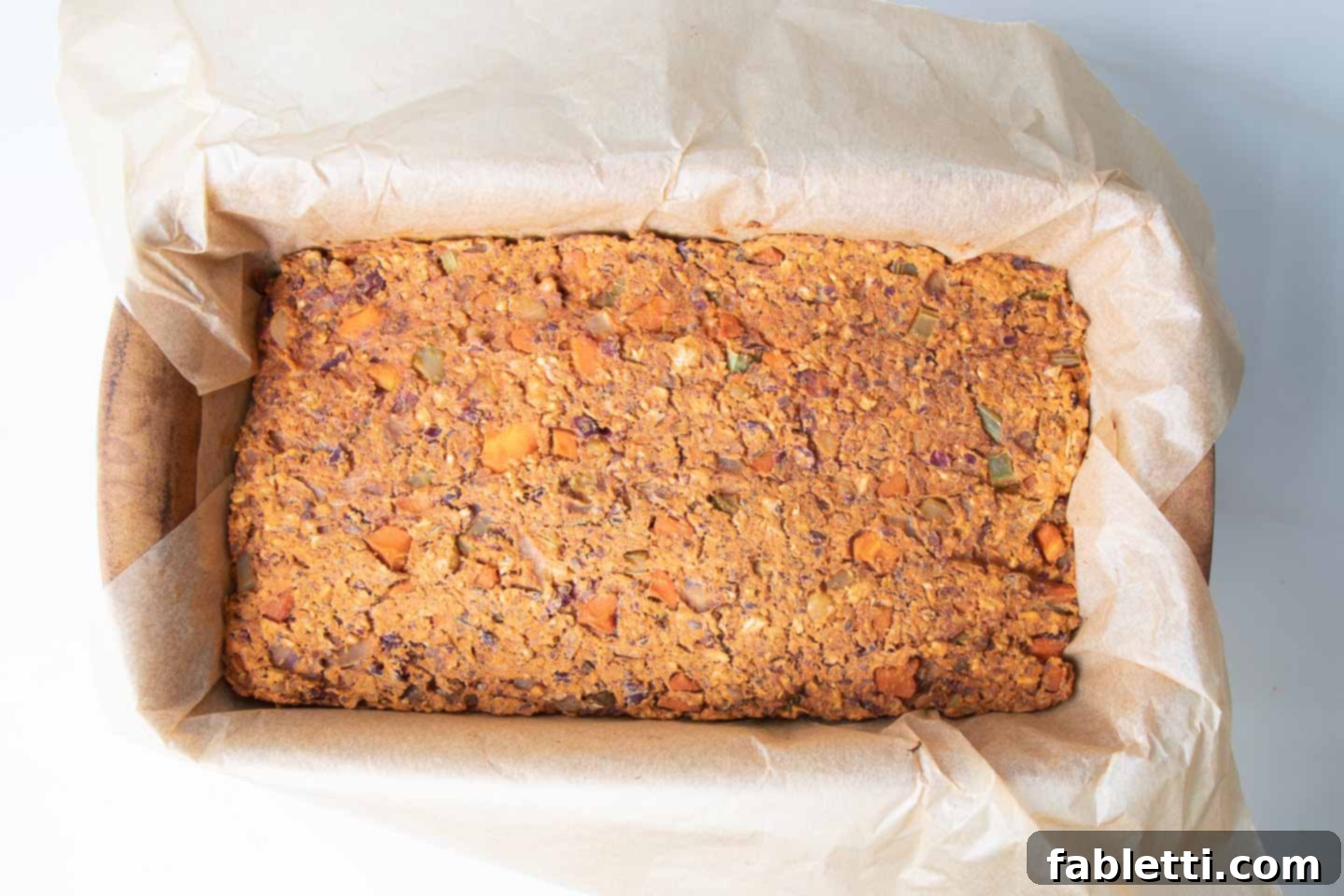
Step 9: Compress and Bake. Use an offset spatula or the back of a spoon to firmly smooth and compress the mixture, removing any air pockets. This compaction is essential for a well-formed loaf. Bake in the preheated 375°F (190°C) oven for 30 minutes.

Step 10: Prepare and Apply the Glaze. While the meatloaf is baking, prepare the tantalizing glaze. In a small bowl, whisk together the tomato paste, apple cider vinegar, maple syrup, whole grain mustard, a pinch of salt, and a dash of pepper. Once the meatloaf has baked for 30 minutes, remove it from the oven and use an offset spatula to spread this flavorful glaze evenly over the top.
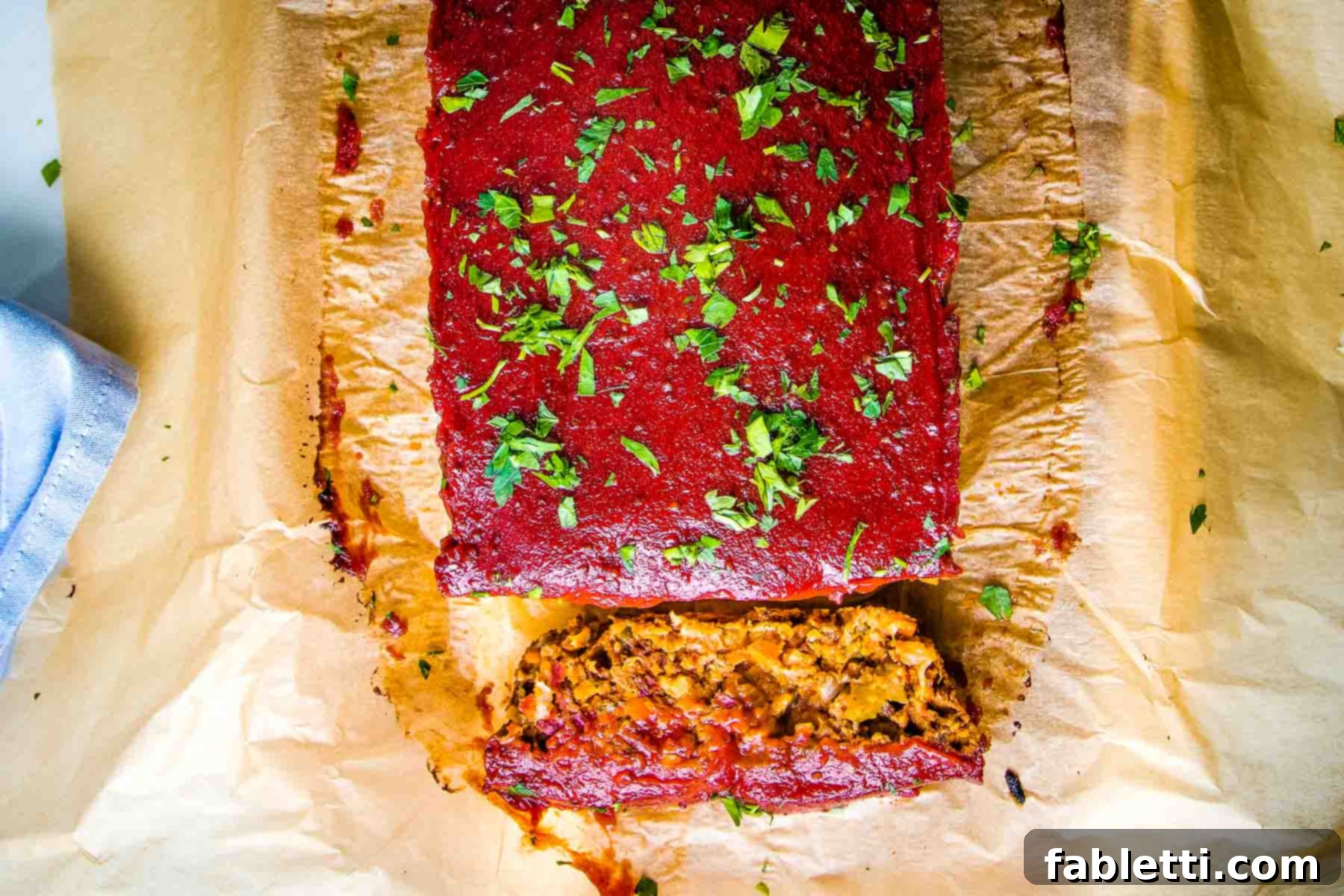
Step 11: Final Bake and Serve. Return the glazed meatloaf to the oven for an additional 25 minutes, allowing the glaze to caramelize and the loaf to finish cooking. Once baked, remove it from the oven and let it cool in the pan for at least 10 minutes. This crucial resting period allows the loaf to set, preventing it from crumbling when sliced. Carefully lift the parchment paper to remove the meatloaf from the pan, sprinkle with fresh herbs like parsley or cilantro for a burst of color and flavor, then slice and serve.

Meal Prep & Storage Strategies for Your Vegan Meatloaf
This vegan meatloaf is not only delicious but also incredibly convenient for meal preparation, making healthy eating easier throughout your week. Its robust nature means it stores and reheats beautifully, ensuring you always have a comforting meal ready to go.
- Make Ahead (Uncooked): You can prepare the entire meatloaf batter, press it into your parchment-lined loaf pan, and cover it tightly with plastic wrap or foil. It will keep well in the refrigerator overnight (up to 3 days) or in the freezer for up to 3 months. When ready to bake, bring it to room temperature before following the baking instructions.
- Make Ahead (Cooked): Alternatively, bake the entire meatloaf, including the glaze, according to the recipe. Once cooled, it’s ready for storage.
- Storage (Cooked): Fully cooked meatloaf can be stored tightly covered in the refrigerator for up to 5 days. A glass loaf pan with a lid is perfect for this, keeping it fresh and ready.
- Freezing (Cooked): For longer storage, freeze slices or the entire cooked meatloaf in an airtight, freezer-safe container for up to 3 months. Defrost in the refrigerator overnight before reheating.
- Reheating: To reheat already cooked meatloaf, place it in a preheated 350°F (175°C) oven for about 25 minutes, or until heated through. If reheating from frozen, ensure it is fully thawed first.
Debra’s Pro Tips for the Best Vegan Meatloaf
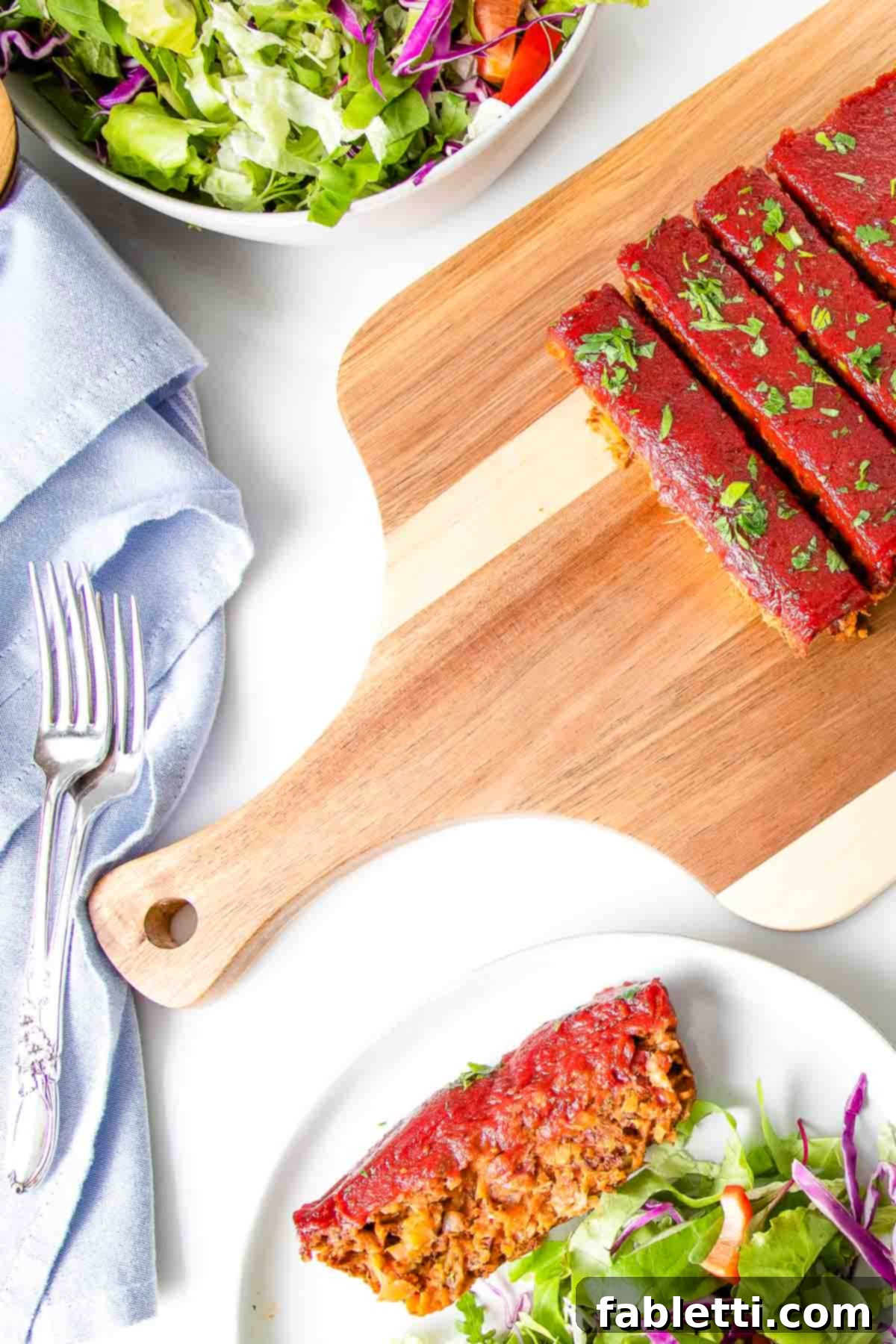
Achieving a truly outstanding vegan meatloaf involves a few key techniques. These expert tips from Debra will elevate your cooking and ensure your meatloaf is nothing short of spectacular:
- Bean Variety for Texture and Color: While this recipe uses a combination of chickpeas and kidney beans for an ideal texture and color reminiscent of ground meat, don’t be afraid to experiment. Pinto beans, great northern beans, or even black beans can be used to achieve varied flavors and hues, all while providing a rich source of fiber and plant-based protein.
- Mastering the Bean Mash: The secret to a perfect meatloaf texture lies in how you mash your beans. Instead of aiming for a completely smooth paste, strive for a mixture that includes both soft, pasty sections and some delightful, intact chunks. This variation will provide a more interesting and “meaty” mouthfeel in the finished loaf.
- Alternative Topping Ideas: If the tangy tomato glaze isn’t quite what you’re in the mood for, consider a savory alternative. A batch of my easy vegan gravy makes a fantastic, rich topping that adds a different layer of comfort and flavor to your meatloaf.
- Effortless Removal with Parchment Paper: To ensure your beautifully baked meatloaf comes out of the pan in one perfect piece, always line your loaf pan with unbleached parchment paper. This simple step prevents sticking and makes transfer a breeze, preserving the integrity of your masterpiece.
- Patient Cooling for Perfect Slices: It’s tempting to slice into a warm meatloaf right out of the oven, but patience is key. Allow the meatloaf to cool in the pan for at least 10 minutes before attempting to slice it. This crucial resting time allows the binders to fully set, preventing the loaf from crumbling and ensuring neat, attractive slices.
What Should I Serve with Vegan Meatloaf?
A delicious vegan meatloaf deserves equally delicious accompaniments to create a complete and satisfying meal. Here are some fantastic plant-based side dish ideas that pair perfectly with this hearty main:
- Dairy-free Garlic Mashed PotatoesCreamy, flavorful mashed potatoes are a quintessential meatloaf companion. This dairy-free version, infused with garlic, is a wholesome and comforting choice.
- Easy Green Salad Recipe with CapersA fresh, vibrant green salad offers a refreshing contrast to the richness of the meatloaf. The addition of capers in this recipe provides a delightful briny kick.
- Easy Recipe for Green Beans with AlmondsCrisp-tender green beans with toasted almonds add texture and a nutty flavor. This simple yet elegant side dish complements the meatloaf beautifully.
- Oven Roasted Crispy BroccoliRoasted broccoli, with its slightly charred edges and tender interior, is a healthy and flavorful vegetable that pairs wonderfully with the savory meatloaf.

Frequently Asked Questions (FAQs) About Vegan Meatloaf
Curious about vegan meatloaf? Here are some common questions and detailed answers to help you master this delicious plant-based dish.
Vegan meatloaf is primarily crafted from plant-based ingredients that mimic the texture and savory flavor of traditional meatloaf. Common bases include mashed beans (such as kidney beans, chickpeas, or black beans), lentils, crumbled tofu, or seitan. These main ingredients are then combined with various vegetables like sautéed onions, carrots, and celery, along with binders such as ground oats or flaxseed, and flavorful seasonings to create a hearty and cohesive loaf.
If you’re looking for alternatives to traditional breadcrumbs in meatloaf, especially for gluten-free or healthier options, you have several excellent choices. Rolled oats (or ground oats, as used in this recipe) are a fantastic binder, offering a good source of fiber. Other effective substitutes include crushed gluten-free crackers, crushed gluten-free chips, or even cooked quinoa or rice, which can add moisture and texture while holding the loaf together.
No, eggs are not a strictly necessary ingredient in meatloaf, particularly in vegan recipes. While eggs typically act as a binder, their function can be successfully replaced with plant-based alternatives. In this vegan meatloaf recipe, ground flaxseed mixed with liquid creates a gelatinous “flax egg” that effectively binds all the ingredients together. This not only makes the recipe vegan but also adds beneficial omega-3 fatty acids and extra fiber, enhancing its nutritional profile.
Your feedback is incredibly valuable! Commenting on and rating recipes is one of the most impactful ways to support your favorite food bloggers. If you tried and loved this vegan meatloaf recipe, please consider leaving a five-star rating below and sharing your thoughts in a comment. We’d also be thrilled to see your culinary creations! Share your photos on Instagram by tagging @dkhealthcoach and using the hashtag #debraklein.
📖 Recipe

Hearty & Delicious Vegan Meatloaf Recipe
Debra Klein
Rate this Recipe
Pin Recipe
20 minutes
55 minutes
10 minutes
1 hour
25 minutes
Main Course
American
6
servings
186
kcal
Equipment
- Parchment Baking Paper
- Potato Masher
- Glass Loaf Pan with Cover
- Offset spatula
Ingredients
Meatloaf
-
1
medium yellow onion
small dice -
3
carrots
small dice -
2
stalks celery
small dice -
1
teaspoon
paprika -
1
teaspoon
cumin -
½
teaspoon
thyme -
½
teaspoon
coarse sea salt -
¼
teaspoon
cayenne pepper -
4
cloves
garlic
pressed -
1
14.5-oz
can kidney beans
rinsed and drained -
1
14.5-oz
can chickpeas
rinsed and drained -
¼
cup
almond milk -
3
Tablespoons
vegan Worcestershire sauce -
1
Tablespoon
Tamari -
3
Tablespoons
tomato paste -
1
cup
ground oats -
3
Tablespoons
ground flax seeds
Glaze
-
½
cup
tomato paste -
¼
cup
apple cider vinegar -
3
Tablespoons
maple syrup -
2
teaspoons
whole grain dijon mustard -
½
teaspoon
coarse sea salt -
½
teaspoon
white pepper
Instructions
- Preheat your oven to 375°F (190°C) and line a standard loaf pan with unbleached parchment paper, ensuring some overhang for easy removal.
- Heat a large skillet over medium heat. Sauté the diced onion for 2 minutes, using a splash of water, vegetable broth, or olive oil as preferred for your dietary needs. Add the carrots, celery, paprika, cumin, thyme, sea salt, and cayenne pepper. Continue to cook for approximately 5 minutes, stirring occasionally, until the vegetables are tender. Finally, add the pressed garlic and stir constantly for one minute until fragrant, then remove the skillet from the heat.
- In a large mixing bowl, thoroughly rinse and drain your kidney beans and chickpeas. Using a potato masher or a sturdy fork, mash the beans, leaving some textured chunks for a “meaty” consistency. Stir in the plant-based milk, vegan Worcestershire sauce, tamari, tomato paste, ground oatmeal, and ground flaxseed. Mix well until everything is evenly combined, then gently fold in the cooked vegetable mixture until it’s fully incorporated.
- Firmly press the meatloaf mixture into your prepared loaf pan, ensuring there are no air pockets. Use an offset spatula or the back of a spoon to compact and smooth the top. Bake in the preheated oven for 30 minutes.
- While your meatloaf is baking, prepare the glaze. In a small bowl, whisk together the tomato paste, apple cider vinegar, maple syrup, whole grain Dijon mustard, coarse sea salt, and white pepper. Set aside.
- After 30 minutes of baking, remove the meatloaf from the oven. Spoon the prepared glaze evenly over the top of the partially baked loaf and spread it to coat. Return to the oven for an additional 25 minutes to allow the glaze to caramelize beautifully.
- Once baking is complete, remove the meatloaf from the oven. Allow it to cool in the pan for at least 10 minutes before gently lifting it out using the parchment paper overhang. This crucial resting time helps the loaf set and prevents it from crumbling when sliced.
- Before slicing and serving, sprinkle with freshly chopped parsley or cilantro for a burst of fresh flavor and vibrant color. Enjoy your homemade vegan meatloaf!
Notes
Plant-Based Milk: While almond milk is suggested, you can easily substitute it with soy milk or oat milk if you have nut allergies or prefer a different flavor profile.
Oats for Grain-Free: If you’re looking for a grain-free meatloaf, replace the ground oats with an equal amount of almond flour or additional ground flax seeds to maintain the binding consistency.
Advance Preparation: This meatloaf batter can be prepared in advance up to step 4. Store the uncooked mixture, pressed into the loaf pan and covered, in the refrigerator for up to 3 days, or in the freezer for up to 3 months. Always bring the mixture to room temperature before proceeding with baking.
Nutrition
Serving:
1
g
Calories:
186
kcal
Carbohydrates:
32
g
Protein:
6
g
Fat:
5
g
Saturated Fat:
1
g
Polyunsaturated Fat:
2
g
Monounsaturated Fat:
2
g
Sodium:
963
mg
Potassium:
630
mg
Fiber:
5
g
Sugar:
12
g
Vitamin A:
5775
IU
Vitamin C:
10
mg
Calcium:
82
mg
Iron:
3
mg
Note
The nutrition calculations provided here are based on online tools and estimations. For the most accurate nutritional information for this or any recipe, it is recommended that you calculate it using the precise ingredients and brands you use. You are ultimately responsible for verifying the accuracy, completeness, and usefulness of any nutritional data presented.
Did you make this recipe?
Please leave a review below, then snap a picture and tag me @dkhealthcoach or use hashtag #dkhealtcoach on Instagram so I can see it!!
